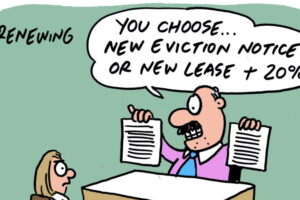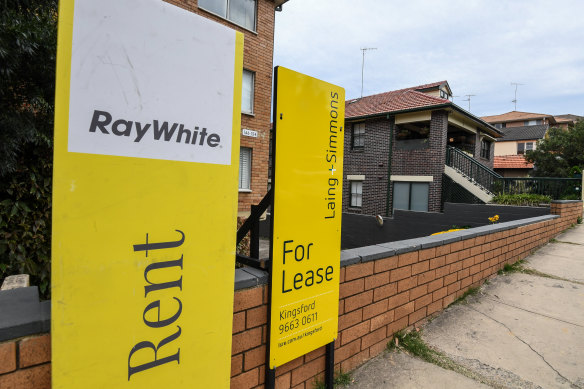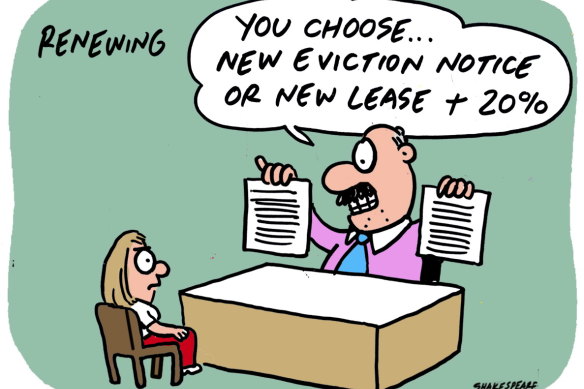Renters like me are ignored by policymakers, and I think I know why

Save articles for later
Add articles to your saved list and come back to them any time.
My flatmate and I have a funny ritual to keep the rent down. It involves a sneeze-inducing chemical and kneeling before our shower drain every two weeks when it goes on strike.
Nothing in our bathroom works as it should, but we don’t complain because we know it’s the reason our rent hasn’t skyrocketed (yet). Cold showers allegedly boost immunity, and it’s a far cry from being left out in the cold.
The rental market is out of control and the lack of urgency from decision makers is compounding the problem.Credit: Peter Rae
Of the 15 to 24-year-olds who live out of home, 84 per cent rent. Within that demographic, my flatmate and I have been lucky. I know because it’s a cohort I speak with every day.
I’m almost certain that if more of the country’s top decision-makers were renters, the current crisis wouldn’t be rearing its head as much as it is. While some politicians are tuned into the issues affecting young people, that’s not always the case.
Most federal politicians own homes. Many are also landlords. Together, the 151 MPs and 76 senators in federal parliament own about 237 houses or apartments – and they have interests in 210 “other properties” including holiday homes and investment properties. Add to that the fact that voters aged 35 and over – the age groups more likely to own a home – account for more than 80 per cent of voters.
So it’s fair to say easing rental pressures or seeing property prices fall may not be seen as a political priority for many of those in power. They have skin in the game. But the longer it’s left, the more that renters, who are disproportionately younger people, suffer and the more likely it becomes that the pressures will manifest in problems like mental ill-health, homelessness and unemployment down the line.
While the most recent federal budget took some steps to ease rental pressures, the extent of the problem hasn’t been reflected in the ambition or speed of policy changes.
Illustration by John Shakespeare.Credit:
The maximum rate of Commonwealth rent assistance – a welfare payment for those renting and already on government income support – is set to be lifted by $31 a fortnight from September (less than the treasurer’s own economic inclusion advisory committee recommended). Given rent on apartments has increased by $200 a fortnight in the past 12 months alone, you’d need to be sharing a unit with at least six other flatmates on rent assistance to avoid feeling the squeeze. My flatmate and I have discussed charging our cockroaches rent.
While rent assistance covered about 50 per cent of a low-income renter’s housing costs in 2000, it covered just 30 per cent by 2022, and it doesn’t stop landlords from lifting rents or tenants from bidding them up over time, if housing remains scarce. At the moment, the national vacancy rate remains near a historical low at 0.9 per cent.
The Greens have suggested a rent freeze. That would provide temporary relief for some tenants, but when you force rents to stay down, it can discourage investment in rentals and reduce rent supply. It’s also not targeted to those struggling the most. That’s not to say some limits can’t be placed. The ACT has had a cap on rent increases since 2015 preventing rents from being increased by more than 10 per cent above the rent component of inflation in Canberra. The city has the highest vacancy rate of Australia’s capitals.
What we really need, though, is increased supply. The more of something there is, the cheaper it tends to become.
Zoning, which discourages development and worsens inequality by placing density limits, needs to be wound back to allow higher-density developments. State or federal governments could encourage this by discounting land tax for communities that allow higher density or providing cash incentives to local councils to do so.
The government recently announced a $10 billion Housing Australia Future Fund to finance 30,000 affordable and social housing homes. But that’s over the next five years and only if the fund generates profit. Given the social housing stock has barely grown in two decades, there’s room for more ambition.
And although Treasurer Jim Chalmers also threw in tax breaks for investment into build-to-rent housing in the recent budget, that will take time to see more houses on the market.
The truth is, like many supply side policies, we are playing catch up. Policy changes should have happened years ago. The construction industry is now crumbling under pressure from cost increases and enormous stimulus-fuelled demand during the pandemic. Housing takes years to build at the best of times.
But as I’ve learnt in my own overpriced shoebox flat, no matter how unpleasant, it’s better to begin unclogging the drain late than never.
There’s also quicker ways to boost supply. About 250,000 short-term rentals were registered across the country in September last year. The government could incentivise at least some of that housing to accommodate longer-term tenants. In Sedona, Arizona, for example, the city council approved $240,000 in funding for a pilot program offering stipends to short-term rental owners who lease their properties for at least one year to a local worker. It might not shift the dial dramatically, but a similar policy here could make a difference.
And lastly, while a move away from stamp duty towards land tax is supported almost universally by economists, we’ve tended to shy away from it or backtrack on it. It’s a move that would help allocate the limited housing that we do have more efficiently, encouraging people who don’t need as much as space to downsize, while also reducing inequality.
We need immediate (if inconvenient) drain-cleaner fixes like providing higher rent assistance and incentives to bring existing housing stock onto the rental market. And although it might take time and money, our housing market needs longer-term changes, starting with loosening zoning restrictions and moving away from stamp duty. I’m optimistic politicians will find the courage to act now and with ambition – and that some of these things will happen before our drain gets fixed.
Millie Muroi is a business reporter for the Sydney Morning Herald and The Age.
The Opinion newsletter is a weekly wrap of views that will challenge, champion and inform your own. Sign up here.
Most Viewed in Business
From our partners
Source: Read Full Article


